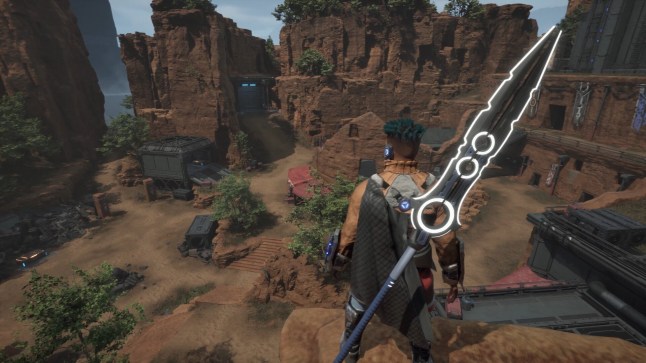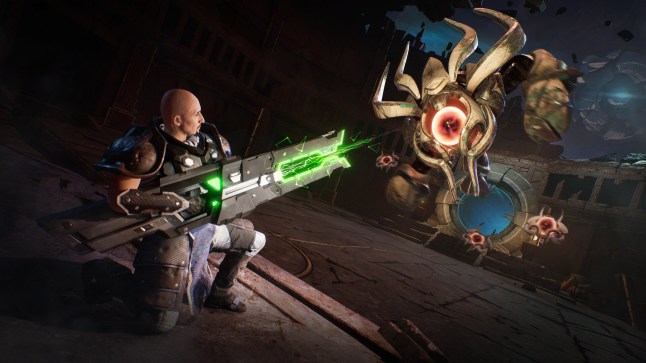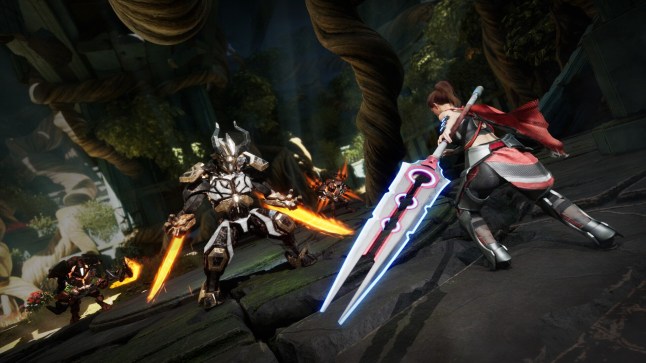
A new indie Soulslike is no mere imitation, as Empyreal offers a clever mixture of guns, melee combat, and a very unusual role-playing system.
Genres can be a slippery thing. Given how many years it takes to make modern video games, summing them up in a couple of words ought to be harder, but in most cases you can tell a driving game from a first person shooter within seconds. Deciding whether something’s an action role-player or an action adventure can take a little longer but, at least in previous generations, most games were fairly clear cut.
Empyreal is at heart an action role-player but with a number of very specific influences. It has fast-paced battles yielding loot, which you use to increase your power, as well as a strong Soulslike influence in its complex architectural level design and the occasional boss that can be a nasty surprise. It’s also got a few roguelite hallmarks, getting you to repeat levels over and over again with differing configurations of loot and enemies.
The game’s plot involves you as part of a skeleton crew visiting a desolate alien world, where a vast black monolith has been discovered. Soldiers sent inside never return and the odd person that manages to escape is so traumatised by the experience they refuse to talk about it. When you arrive on the scene nobody knows what’s going on. What’s the monolith for? And why is there absolutely no sign of the civilisation that built it?
Entering via a massive circular portal, your first trip into the towering structure reveals dilapidated brick ruins populated by groups of armed robots who immediately attack you. When you fight your way through them all and get to the exit, you find out from fellow expedition members that what you’ve seen is just a small taster. The monolith is actually immensely bigger on the inside than even its colossal exterior would imply.
Divided into four quadrants, your job is to explore each, attempting to get an idea of its layout and above all its purpose. Rumours around the camp suggest it could be an elaborately designed prison for a murderous entity, and that exploring it is a very bad idea. Naturally you’re unmoved by that sort of gossip, continuing the process of uncovering the monolith’s labyrinthine interior.
Your starter weapon is decided by the background you choose for your character during customisation. On subsequent forays through the portal, you can choose to be equipped with the nimble, bladed glaive; the heavy mace and shield; or a portable cannon. The latter, in particular, proves highly unusual in its mechanics.
Rather than choosing a gun type and picking up ammunition for it, you equip the cannon with shotgun shells, gatling rounds or sniper bullets simply by timing your reload differently, effectively changing the kind of gun you’re using as situations dictate. Added to that, if you time it perfectly and hit the sweet spot while reloading the whole magazine comes with higher powered rounds, a process you can repeat two more times for supercharged ammo.
It makes combat varied and flexible, and means you’re no longer subject to the game designer’s whim when it comes to which weapon you can use. Instead, you make your own choices and change your mind as you see fit. Since you’ll be taking on diverse groups of enemy robots at a variety of ranges, that’s a useful feature.
With the cannon you can dodge incoming attacks, while using the glaive you can also parry. The mace is too heavy for dodging but does let you parry, giving each of the three armament set-ups their own unique feel. Unlike ammo, you can’t change your weapons loadout on the fly and instead you need to visit one of the armament tables in the game’s hub between runs.
In the hub you can unlock artefacts you loot – like decoding engrams in Destiny – before equipping or selling them. You can also shop for consumables and, like Hades, chat to characters you meet. It’s sparsely populated, so you get to know everybody reasonably early on: there’s John the friendly Yorkshire blacksmith who likes his Newcastle Brown, Edmund your irascible commander, Raulin the war story-telling Scottish quartermaster, and a scattering of other misfits.

Intriguingly, each has their own quest line with potential fail states and multiple endings, so what you decide to say to them and which goals of theirs you fulfil, have a lasting effect on what happens at HQ. It also allows the game to drip feed plot and lore to you, because much like Souls games, not much is explicitly stated. Instead, you’re left to infer almost everything from trial, error, and experience.
Making progress involves two things. For your character, equipping higher level gear increases your power. There are no experience points, just an average level across every piece of kit you have equipped. The second is to install mods, which increase or add new bonuses to gear you own. It’s another odd system, often bartering part of one stat to add to another, but like everything in Empyreal, you do eventually get the hang of it.
Each of the four quadrants has a distinct biome and personality, although the enemies you meet, what elemental attacks they use, and the level and types of loot available, are governed by cartograms. You’ll find those along with loot as you win fights, and each one gives discreet access to part of one of the quadrants, with its own unique mix of enemies and loot.
The trick is that each cartogram comes a finite number of reset charges, which let you continue when you die. Use them up and you you’re stuck with just one life, and cartograms themselves are destroyed when you complete them, defeating the final boss and extracting your gathered loot. Fortunately, they’re in plentiful supply so you never run out, but if there’s a particular area you’re keen to see more of, it can take a while to find that specific cartogram again.
It took us about 10 hours to get to the final boss, and a couple more to get back to it and see it off, but Empyreal is designed with New Game+ in mind, which lets you continue levelling and explore parts of each gargantuan quadrant that you had previously not seen, or were killed too quickly to fully appreciate. It’s an excellent way to experience in-game systems created to change subtly as your powers increase.
Inevitably a sense of repetition does set in. Despite their scale, levels are finite and handcrafted – no procedural generation here – and even though you’ll be fighting different enemies and bosses, there does come a point where you feel as though you’ve seen all you need to.
Fights are brutal and fast, with many attacks coming from offscreen, meaning you need to block or dodge as a matter of routine. For those used to FromSoftware’s weightier, more measured combat, this may seem too scattershot, even if most of its encounters still manage to feel satisfying.
The other minor concern is camera control. With no lock-on and multiple enemies having at you at any given time, it can be tough to know where to look, and the fast-moving manually controlled camera frequently adds to the sense of barely controlled chaos. The splashy special moves you constantly trigger only add to that.
Still, the fights are intense and the exploration full of secrets and surprises. You’ll often find a lengthy new path unexpectedly loops back to places you thought you knew well, a previously locked door in an empty room turning out to be the way back from your freshly discovered meander.
It may be a bit rough around the edges, but Empyreal is loaded with good ideas and innovative thinking. It borrows from a range of popular sources but has plenty of entirely original ideas of its own. Given its open-ended structure, and levels created to hide secrets even after multiple visits, Empyreal is a refreshingly different experience that’s reminiscent of multiple other games without ever copying any of them exactly.
Empyreal review summary
In Short: A complex interconnection of influences results in a game that’s both familiar and interestingly unique, with a few rough edges compensated for by excellent combat and role-playing systems.
Pros: A fascinating game world to explore, its four quadrants proving far larger and less predictable than anticipated. Great bosses and enemy variety, with an engaging role-playing meta game.
Cons: Manual camera is not helpful, especially in a fight. Many attacks arrive unflagged from offscreen and the game does eventually get repetitive.
Score: 7/10
Formats: PlayStation 5 (reviewed), Xbox Series X/S, and PC
Price: £24.99
Publisher: Secret Mode
Developer: Silent Games
Release Date: 8th May 2025
Age Rating: 16

Email gamecentral@metro.co.uk, leave a comment below, follow us on Twitter, and sign-up to our newsletter.
To submit Inbox letters and Reader’s Features more easily, without the need to send an email, just use our Submit Stuff page here.
For more stories like this, check our Gaming page.